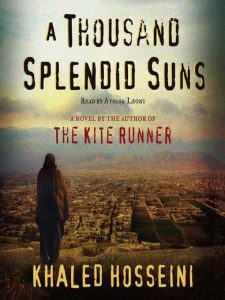Christina Bagni // Blog Writer
With Charlie Hebdo, a Hajj stampede, hijab fashion shows, and Donald Trump threatening to kick out all American Muslims, this fall was definitely a relevant time for me to take a history of Islam class. Beyond some basics, I didn’t know too much about Islam beforehand, but I certainly do now, and I suggest everyone with an interest in history, religion, current events, or human rights take Islam in the World (HI-204, if you’re curious).
As the final project, we got a choice—either do a research project, or something creative. Professor Carol Ferrara’s first example was to read and report on a novel concerning Islam, and as a Writing, Literature, and Publishing major, I latched on immediately. I’d had A Thousand Splendid Suns by Khaled Hosseini on my Goodreads “to read” shelf for a while, and I decided there was no better time to get cracking.
The novel follows two Afghan, Muslim women over the span of about forty years. Not only does it touch on several important moments in Afghan history, but it shows how the Taliban taking over affected the lives of everyday women. Laila, a young girl born in 1978 who was raised to hold her head high and uncovered, taught by her father and female school teacher that it was a good time to be a woman in Afghanistan and that she had the world at her fingertips, witnesses all that promise fall apart with the explosion of a bomb. She finds herself with no choice but to marry Rasheed, an abusive man decades older than she is. He forces her to wear a burqa1 and never leave the house without him (both of which later become law under the Taliban). Rasheed also already has a wife, Mariam, who is nineteen years older than Laila and takes far more abuse, both physically and emotionally, from Rasheed. The story follows the women as they grow from icy strangers to sisters under the harsh rule of both the Taliban and their husband.
Even though “A Thousand Splendid Suns” spends quite a bit of time exploring the harshness of the Taliban and what their radical ideas meant for men and women living under their rule, it spends far more time ripping your heart into a million pieces, putting it back together, and shredding it up again. Both women go through hardship after hardship, and you feel every one as if it were your own. Thankfully, Hosseini’s writing is emotional enough that you feel every victory too, small as some of them are. At the center of the novel are themes of rejection, oppression, and boundless love, all of which are relatable to anyone, even if you don’t know the first thing about Afghan history or Islam. If you DO know your stuff, rest assured that the novel is extremely accurate to real life, so there’s no fear of being taken out of the moment by any artful rearranging of history.
My favorite part—and I’ll keep this as spoiler-free as possible—is when one of the women comes across a loved one she hasn’t seen in a very long time. After more than half a novel’s worth of getting my hopes shot down, I expected this person to be a figment of her imagination, or for their reunion to all be a dream. My disbelief was mirrored in the woman’s reaction. As it slowly becomes more apparent that the person is real, both the reader and the character begin to feel hopeful of change, and begin wondering what this means for the future. The way that Hosseini crafted that scene to make the character and the reader feel identical emotions is incredible, and any writer could benefit from studying that passage.
Overall, I highly recommend “A Thousand Splendid Suns” to anyone who likes history, as well as anyone who likes good literature. It is a beautifully crafted novel rooted deep in Afghanistan’s history, with moments ranging from painful rawness to gorgeous moments of salvation. Reading it will not only be enjoyable but will also offer a close look into a world many of us don’t know much about, or only see one side of.
1 Many Muslim women wear burqas by choice and do not see them as signs of oppression. Similarly, hijabs and other sorts of headscarves are not signs of oppression outright, and are often worn by women (such as A Thousand Splendid Suns character Mariam) willingly for modesty, fashion, adherence to religion, or any number of reasons. However, in this context, where it is forced upon the woman unwillingly by her husband, it is a symbol of his and the Taliban’s power over her and other Afghan Muslim women. The “forcing” more than the “burqa” is the oppression.

